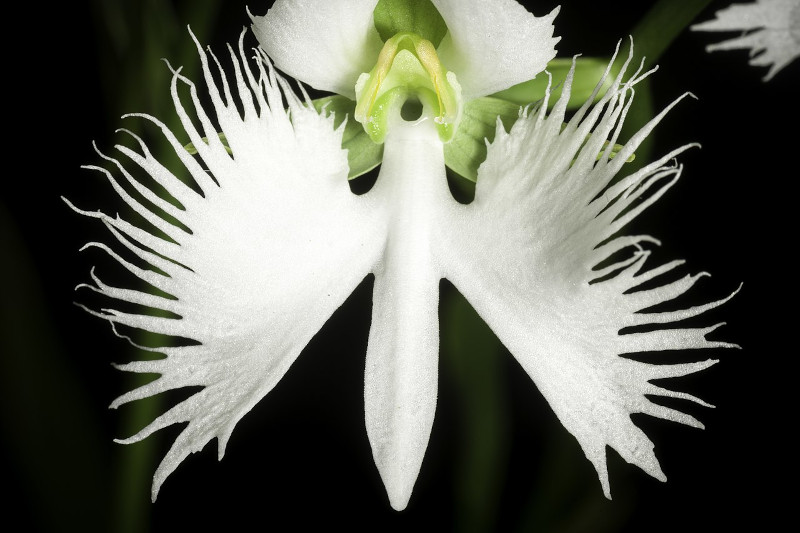White Egret Orchid Facts
- The attention-grabbing term of White Egret Orchid understandably serves as the most frequently used common name for this botanical marvel. Yet, this botanical beauty does have a few other general titles it’s known by. These include the terms fringed orchid or sagisō.
- Inside of the scientific community, however, it’s perhaps better knnown by its technical designation. Thankfully, though, that’s a comparatively simple one for the layperson to pronounce. That’s because the plant holds the official epithet of Pecteilis radiata.
- This marvelous product of evolution received that appellation due to the efforts of Carl Peter Thunberg. The noted Swedish naturalist accomplished the first official recognition of it as a separate and distinct species. He achieved that scientifically noteworthy feat in 1784.
- This wonder of the biological world clearly represents a truly unique and extremely beautiful species, even among orchids. It also demonstrates an intriguing coincidence. Due to a random quirk of evolution, its shape suggests to many the shape of wings spread for flight.
- Fortunately, the White Egret Orchid appears to still be maintaining a population base that’s both stable and sufficient. That pleasant state also seems to hold true across the entirety of its native range. The IUCN thus does not show it on their Red List of Threatened Species.
- The remarkable flora nevertheless still faces the same potential threats to its continued existence as all species one earth today do. Most of those dangers stem from the actions of mankind. They include the closely related perils posed by habitat loss and climate change.
Related Articles
White Egret Orchid Physical Description
The appropriately-named White Egret Orchid constitutes an amazing terrestrial species of orchid. In terms of form, this highly amazing plant itself qualifies as what’s listed as a small shrub. That unique fact alone distinguishes it from the majority of its many relatives located around the world.
The stunning flowers the plant produces, however, appear on individual stems. These features also typically grow strongly vertical, and relatively slender in structure. Though these vary, an average height ranges from approximately 8 – 24 in (20 – 60 cm) under normal growing conditions.
The leaves of this marvel Nature and evolution usually develop as lance-shaped in form. These also generally vary in size, depending on the specific growing conditions. They often form a basal rosette at the bottom of the plant. In color, these range from very light to dark shades of green.
It’s the utterly breathtaking blooms of the White Egret Orchid that typically recieve the most attention, however, and justifiably so. Each plant generally produces either two or three of these magnificent blossoms per stem. Yet, exceptional examples sometimes develop as many as eight.
The distinctive white shading of each individual flower easily stands out in sharp contrast to the bright green of the stems and foliage of the remainder of the plant. Along the edge, or lip of the beautiful orchid, an adornment of yellow markings usually appears, resembling an egret’s bill.
The calyx also generally develops as somewhat egg-shaped in design, while the sepals develop relatively small and green. Most noteworthy, however, are the three lobes. The two largest extend laterally and develop fringed edges, which serves to further accentuate the appearance of wings.
- Kingdom: Plantae
- Phylum: Angiosperms
- Class: Monocots
- Order: Asparagales
- Family: Orchidaceae
- Genus: Pecteilis
- Species: P. radiata
White Egret Orchid Distribution, Habitat, and Ecology
To the delight of many, the marvelous White Egret Orchid evolved as native to a moderately broad expanse of the surface of the earth. The precise location of that zone of habitation likely won’t surprise many people, either. That’s because this natural wonder developed as native to Asia.
Within that vast overall habitat range, however, the flora’s only known to be present within the confines of the general eastern section. This region primarily consists of the countries of Japan, China, Korea, and certain portions of Russia. It’s possible it also exists beyond this known territory.
Aiding in its survival is the fact that it demonstrates an impressive flexibility regarding its choice of habitat types. It’s therefore found in a wide range of ecoystems within its range. These settings include locations occurring at both moderate to unusually high altitudes for orchids.
Inside of these ranges, though, the intriguingly versatile beauty makes its presence known with a great multitude of settings. These include grassy areas and meadows, where it thrives in open, sunny conditions. Such provide the orchid with the necessary light and space to grow and bloom.
The mind-numbing Angiosperm also often occurs in the margins of open forests, where there’s enough sunlight reaching the forest floor to support its growth. In these habitats, it’s quite frequently found growing among various low vegetation or along the edges of woodland clearings.
It prefers well-drained soil, and is frequently found in various soil types, including both sandy and loamy soils, and rocky substrates. While it prefers well-drained soil, it also requires a moderate level of moisture to thrive. Habitats with periodic rainfall or access to moisture seem to work best.
Like its many kindred across the globe, the White Egret Orchid relies on specific pollinators for reproduction. In its natural habitat, it’s mainly pollinated by insects, especially bees and butterflies. Its shape and scent attract these, which transfer pollen between flowers as they forage for nectar.
After their successful pollination, the remarkable product of Nature produces multiple, very small capsules containing numerous tiny seeds. The dispersal of these is subsequently most often facilitated by either local winds or by animals that may inadvertently carry them to new locations.
Species Sharing Its Range
Check out our other articles on 9 Truly Magnificent Mantises, Mitchell’s Satyr Butterfly, Clouded Leopard, Cocos Island, Mountain Chicken, Mary River Turtle, Blood Iris, Philippine Cobra

